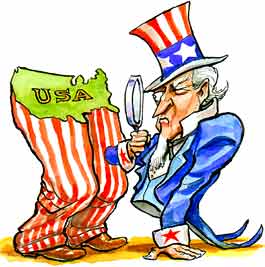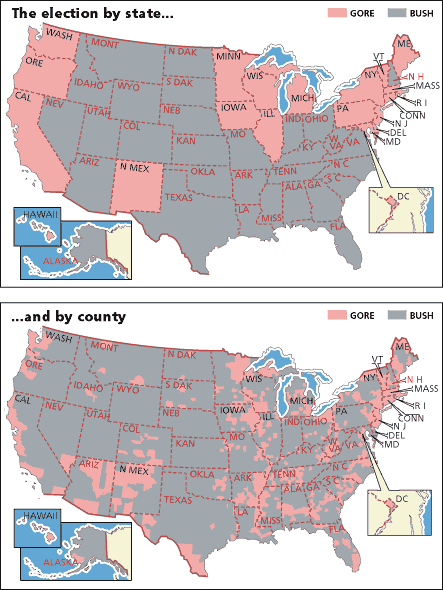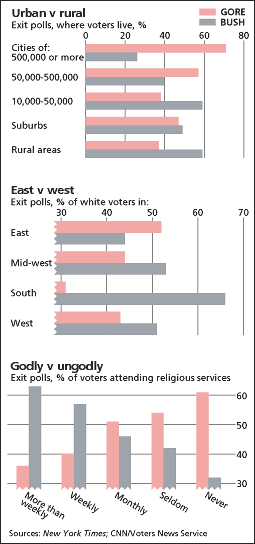|
|
Este informe no está disponible en español.
 The Economist The Economist
One Nation, Fairly Divisible, Under God
Americans are divided about whether their country is itself divided. Some see a yawning culture gap between conservatives and liberals. Others see a soggy moderate centre. Both are right.
January 18, 2001
Copyright © 2001 THE ECONOMIST. All Rights Reserved.
IN DECEMBER 1999, as George Bush entered the Republican primaries, Gertrude Himmelfarb, a distinguished social historian, published a book entitled "One Nation, Two Cultures". In it, she argued that America was becoming two countries. One, rooted in the 1960s, is hedonistic, individualistic and secular. The other, grounded in the 1950s, is puritanical, religious and family-centred. Such distinctions go back a long way. In 18th-century Britain, Adam Smith called them the "loose" and the "austere". Michael Barone, a commentator for US News & World Report, calls their current embodiment "the Beautiful and the Dutiful".
A year before Miss Himmelfarb’s book, as George Bush was wondering whether to run at all, Alan Wolfe published an alternative view. In "One Nation, After All", he argued that, far from collapsing into warring cultures, America is dominated by a fairly homogenous middle class whose cardinal virtue is tolerance. This class, argued Mr Wolfe, lives in a land of "quiet faith", "ordinary duties" and "morality writ small". If there is a culture war, it is within individuals, as they try to strike a balance between the cultures of the 1950s and 1960s. They are neither beautiful nor dutiful. Mutable, perhaps.
As Mr Bush prepares to take the oath as America’s 43rd president, the question of who is right, Miss Himmelfarb or Mr Wolfe, seems more than usually acute. This is only partly because Mr Bush’s prospects for success hinge on the answer. More vitally, there is a great deal of exit-poll evidence that America is indeed becoming, in some ways, "one system, two nations". Ex uno, plures.
The argument begins with the narrowness of the result. The votes for the presidency, the Senate and the House were more or less tied. At state level, Democrats now control both houses of the local legislature in 17 states; Republicans control both houses in 18 states. Yet this was not a freak election. The past three congressional-election votes have all been squeaky-close, with both parties getting around 48-49% in each of them. Bill Clinton was also re-elected president with 49% of the vote. As Mr Barone says, this is the same number, over and over again.
In the 1990s, both parties had hoped to create decisive governing majorities: the Democrats on the back of Mr Clinton’s move towards the centre, the Republicans by trying to become the party of the "new economy". Both failed. Instead, for the first time since the 1880s, America has gone without a dominant party for a whole decade.
Political stasis, of course, is not the same as political division. It could be produced, for example, by an even split in each main constituent group in the country. But that seems unlikely. American political parties have become ideologically more coherent since the 1960s, when conservative Democrats in the South defected to the Republicans, mirroring the decline of liberal "Rockefeller Republicans" in the north-east. And it does not seem to have happened in the 2000 election.
Look at the first electoral map above. Mr Bush’s states form a broad band running down the Rockies and across the South. This is America’s interior heartland, home of the "dutiful" people. Mr Gore, on the other hand, won the godless coasts and the industrial mid-west. Democrats have won the biggest cities for generations. This time, they won the smaller metropolitan regions too. Mr Gore won metro areas with more than 500,000 people by 71% to 26% (see chart "Urban v rural", below), easily the largest margin since this figure has been tracked. He also won the congested suburbs of the north-east and southern California. This is where the "beautiful" Americans live.
David Brooks of the Weekly Standard calls this the "Ice Age" division. Democrats won those areas which, when the glaciers receded, were either carved by rivers into ports which became big cities (the coasts), or were scraped clean to leave them too poor to support anything but car factories (the mid-west). Republicans won the areas that received all the topsoil the glaciers deposited, turning them into rich farms or ranches.
More important than geology or geography is that different types of people voted for the two sides. Blacks voted overwhelmingly for Mr Gore, white men for Mr Bush (see chart "East v West", above). Unfashionable though it is to say so, the 2000 election revealed the racial divide in American politics more sharply than in the recent past.
This was largely a southern phenomenon. White southerners voted for Mr Bush by a 35-point margin. Ronald Reagan received an even larger margin in 1984; but he had margins almost as big among whites elsewhere. Mr Bush did not. Outside the South, he beat Mr Gore by only 3 points or so. In other words, Mr Bush overwhelmingly needed white southern men for victory. That chimes with other evidence. Nearly half of all voters said they had a gun at home, the highest such figure ever recorded; 61% of gun-owners voted for Mr Bush.
But of all the determinants of voting behaviour, religion was the most precise. The more often voters went to church, the more likely they were to vote Republican. Of those who never go, 61% chose Mr Gore, 32% Mr Bush. For those who go more than once a week, the votes were reversed (see chart "Godly v ungodly", above). It is almost a perfect fit. Mr Barone points out that Mr Gore won the two counties with the lowest church-going rates, Manhattan and Los Angeles County, by margins comparable to the biggest Democratic landslide in recent history (Lyndon Johnson’s defeat of Barry Goldwater in 1964). Yet Mr Bush won Montana, Wyoming and Idaho by rates approaching the biggest Republican landslide in recent history, Richard Nixon’s defeat of George McGovern in 1972.
Put these patterns together. As Bill McInturff, a Republican pollster, told the Washington Post: "We have two massive colliding forces. One is rural, Christian, religiously conservative. [The other] is socially tolerant, pro-choice, secular, living in New England and the Pacific coast." Miss Himmelfarb could hardly have put it better herself.
Multiple melting pots
A single election is a slender base on which to argue how a country has changed. Nevertheless, there are other reasons for thinking that the patterns of the 2000 election may be valid for the longer term.
They come from the new census. For decades, two broad trends have been reinforcing one another to redraw the demographic map of America. These are, first, the internal migration of Americans from the north and mid-west to the South and south-west ("the Sunbelt" at the broadest definition of that over-used term); and, second, immigration from outside, mostly from Latin America, to those same states. The two have worked together to produce a booming Sunbelt and a brisk new stirring of the ethnic melting pot.
Both trends are continuing. But research by Bill Frey of the University of Michigan suggests that they are now going in different directions. This finding gives more credence to the argument that America is becoming more deeply divided.
Between 1990 and 2000, the combined voting-age population of Hispanics and Asians rose by almost 10m to 30m: 10% of the population, almost twice what it was in 1980. That is an acceleration of an old trend. What is unusual now is the concentration of the growth. More than 60% of the increase occurred in just four states: California, Texas, Florida and New York. Mr Frey calls these the new melting pots (he adds Hawaii, New Jersey and New Mexico, which have similarly high levels of immigration).
Meanwhile, other states are getting whiter. The white voting-age population rose by more than 22% in the western states of Nevada, Utah, Idaho, Arizona and Colorado during the 1990s. Most of the white migrants came out of California. In the South, Georgia, North and South Carolina and Tennessee also saw their white voting-age populations increase by more than twice the national average. These too are Sunbelt states. They are still growing economically. The difference is that the new Sunbelt is attracting whites (and blacks) from elsewhere in America. The melting pot is attracting foreigners. The Sunbelt is splitting in half.
This has profound political implications. The states gaining white populations form the spine of Mr Bush’s band of victory, running down the Rockies and through the South. With three exceptions (Oregon, Washington and tiny Delaware), Mr Bush won every fast-growing state outside the melting pots. With two exceptions, Mr Gore won every melting-pot state. His exceptions–Florida and Texas–are revealing. Both had governors called Bush. And they are the two states with the largest absolute number of white migrants (as well as large numbers of Latinos). They thus complicate but do not contradict the basic link: there is a close overlap between the short-term trends of the 2000 election and the longer-term figures from the 2000 census.
Cut another way
So is America one nation, two cultures? Before saying yes, consider a different interpretation of some of the same figures, starting in the same place: with America’s current political make-up.
This is the first time since the 1920s that one party has held the presidency, the House of Representatives, the Senate, a functional majority on the Supreme Court, and a majority of both state houses and governors. If you look merely at voting margins, there is a dead heat. If you consider the direction of politics over time, there has clearly been a small shift to the right. Ben Wattenburg of the American Enterprise Institute (AEI) doubts that this points to any fundamental realignment but argues that, if Republicans establish a renewed political dominance in 20 years’ time, historians will point to the 2000 election as the first clear evidence of it.
Now consider the electoral map broken down by county (second map). This shows a far more complex pattern. Instead of one big Republican band separating two Democratic blocks, the new map is like a scatter diagram. Most of the map is grey because Mr Bush took the rural acres. But he won clusters in almost every Democratic state, and took New Hampshire, the state with the highest proportion of "new economy" workers. Conversely, Mr Gore won clusters of votes in every Republican state bar Wyoming, Utah and Nebraska. The Gore enclaves are usually towns or universities, or strung out along the Mississippi. But Democrats won even in Republican heartlands.
It is true that the county-by-county map confirms, rather than denies, the existence of an urban/rural split in America. But too much can be made of this division. Over half of Americans live in neither of these areas, but in suburbs. And suburbia itself is more varied than it looks. Inner suburbs look like the cities they adjoin (and trend Democratic). Outer "exurbs" are usually Republican. In between, the traditional suburbs split more or less down the middle, but in ways that fit no clear pattern.
More important, the census gives an entirely different account of what is happening in this suburban middle ground. At least as striking as the rise in immigration or the change in internal migration is a demographic development that in any other country would be called the collapse of the lower-middle class.
Bill Galston of the University of Maryland argues that, since 1970, the poor and working poor (those with household incomes below $25,000 at constant 1999 prices) have slipped only a little as a share of the total population, dropping from just over a third to just under a third. What he describes as the poorer middle class has declined as a share of the total by over ten points (38% to 28%). The richer middle class and the rich, on the other hand, (those with household incomes over $50,000, of which the very rich are a small part) have risen by almost 15 points from just over a quarter to over two-fifths. In other words, the largest single group of Americans now is the fast-growing rich middle class.
These are the people living in the suburbs: the mythical "soccer moms", socially liberal, economically conservative folk concerned about their children’s schooling, their commute to work, their new Palm Pilot. Their attitudes contradict the notion that America is an apartheid democracy. Largely because of the economy’s growth in the past decade, traditional economic-interest-group arguments play little part in their politics (though that may well change if recession comes). Instead, they are mostly concerned about "values"; and Mr Wolfe found endless evidence that the value they most admire is tolerance.
For the past 30 years, around 40% of Americans have described themselves as moderates. That share reached 50% in the 2000 election. That, suggests Karlyn Bowman of the AEI, may be a spike; but it still means a plurality of the population sees itself this way, and has done for years.
Suburban moderation cuts across the religious and ethnic lines so evident in the census and election returns. Public Agenda, a polling organisation, has found that large majorities of Americans see religion as primarily a guide to morals and good behaviour (rather than, say, a matter of faith or ritual), and do not want to foist their religious opinions on workmates or friends.
Similarly, the racial divide may be changing in the suburbs. One of Mr Frey’s most intriguing findings is that, in the 1990s, blacks reversed their long trend of leaving the South for the cities of the north and began returning–this time to the sprawling suburbs around Atlanta and other southern cities. In the 1990s, the South had a net gain of 326,000 adult blacks from the rest of the country. Most are suburbanites or retirees. In Clayton County, Georgia, for the first time, black incomers have a higher educational level than existing residents.
So far, this has not altered black voting patterns. But other ethnic groups are following the trail, first blazed by Italians, Poles and others, away from identity politics and towards assimilation. One-third of Latinos voted Republican. In Texas, the figure was 43%; in Florida, 50%. And there you can see the political affiliations reversing. Cubans in the city of Miami have traditionally voted Republican. The younger generations who have left for the suburbs of Broward County, to the north, are more Democratic. Cutting across the divide between the two cultures is a different pattern: the growth of a large, tolerant, middle-class suburbia.
That is sometimes used to suggest that America is split only shallowly, rather than deeply. But that does not do justice to the evidence of cultural division. It would be better to think of America as a bell shape. At the edges are the two sharp tails of the cultural and social divide. In the middle is a bulge of moderate opinion. The test of Mr Bush’s presidency will be whether he marginalises the centre and encourages the tails, or whether he ignores the tails and appeals to the centre, as his campaign promised to do.
|

